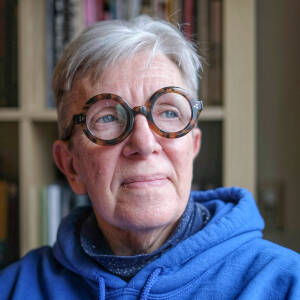Michael Premo: Documentary Storyteller
That’s Michael Premo addressing a group of us who came to hear his vision of “Visual Storytelling as Activist Strategy.” We might call him a photographer and film maker, but he calls himself a “documentary storyteller.” He’s in Portland showing his photographs of a grassroots campaign to defend eastern Canada’s water supply from fracking by a powerful Texas energy company. He explains that photographs and films recorded with the activist community that fought fracking were part of the winning strategy that chased the frackers out of Canada. In order for that campaign to be successful, a critical mass of people had to be engaged--people who don’t consider themselves “activists,” people who would not join a demonstration or march. This mass of people was reached through exhibits of photographs in public buildings and art galleries, in community centers and city halls. He urges those of us who are photographers, videographers, film makers, and workers in mixed media to go beyond photojournalism to create images that are themselves part of the movement for change. His ideas are right up my alley, and I was transfixed by his presentation.
Premo’s background, like mine, is in performance. It was “drama” back when I was an undergraduate, and it was a white-guy-thing that began with the Greeks and ended with Jerzy Grotowski; it became “theatre” around the time I earned my my Ph.D., as it expanded to include oral history, storytelling, dance and ritual performances all over the globe. Influenced by anthropology and participatory research, during the 90s it became “performance studies” and included improvisational or “guerilla” theatre pioneered by Augusto Boal--for community education, development and social change. (That’s what I was doing in Africa for six years.)
The changing names of our discipline reflect more than an effort to make theatrical activity relevant, although that’s part of it. We began to see our art as all that is performed: words, movement, ritual, art installations, street theatre, protests, even everyday life. So it was easy for me to see how Michael Premo, who could have been one of my students, might call his work “documentary storytelling” instead of photography or photojournalism.
I could go on, but if you’re interested, have a look at Michael Premo’s website, here, where you can learn about that successful anti-fracking project, watch a trailer for a film about the aftermath of Hurricane Sandy, and see some stunning photographs and hear the voices and soul-gripping stories of some unhoused people. I congratulated Michael after his talk, shook his hand, and slipped away trying not to cry in front of him, too shy to tell him I felt as if I could be his spiritual mother. Or grandmother. I’m grateful that he is in the world doing the work he’s doing. He and a few more like him just might save what’s left, but he warns, making me grit my teeth, that we need to “tone down” our language in order to appeal to that critical mass necessary to make change. We might have to talk about “nature” instead of climate change, about “fairness” rather than social justice. He says we need to avoid sounding “too liberal” because many in the USA are afraid of what they think that means. Hearing that did not help my headache any, but he may be right. Also on the program was Molly Murphy, of Working Films (see Extra) who led the discussion about the need for “toned down” language.
Premo mentioned in passing a book I’ve put on my list to read as soon as I can, Rebecca Solnit’s A Paradise Built in Hell: The Extraordinary Communities that Arise in Disaster. Solnit looks at how altruism, compassion, and social action arise when people are threatened by catastrophic events and bond to help each other.

Comments
Sign in or get an account to comment.


